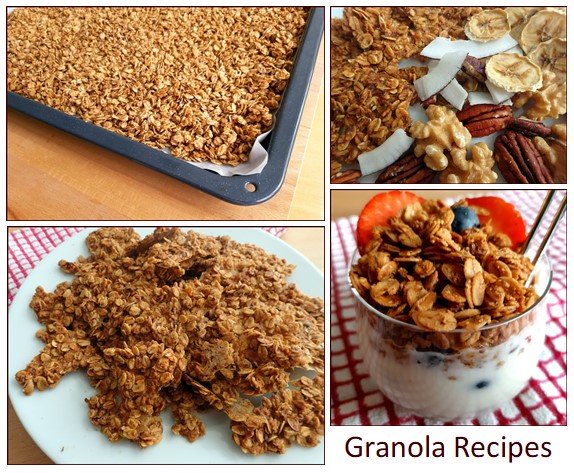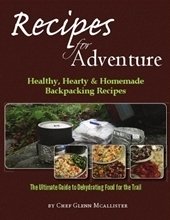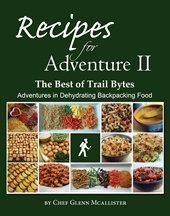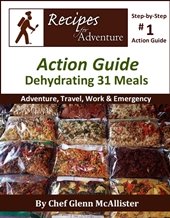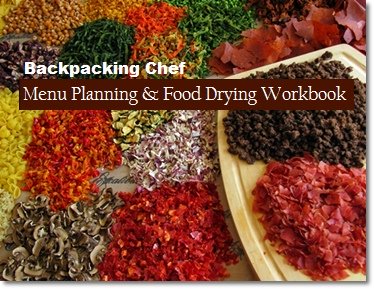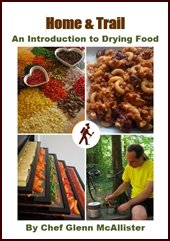How to Make Granola with Healthy Ingredients
We hikers eat a ton of granola, so learning how to make granola makes sense if you want to save money over store-bought granola. You also get a health boost by using nutritious ingredients.
This article presents my best recipe for granola. Sweetened naturally with real maple syrup or honey, and fortified with seeds and chopped nuts, you will love the sweet crunch of this healthy, homemade granola.
Enjoy DIY granola at home or on the trail:
- In trail mixes.
- For breakfast with fruit and milk.
- As a topping for ice cream and yogurt.
Make Fruit & Granola Clusters in your dehydrator by combining blended fruit with granola. They're amazingly delicious, and I include the recipes in this article.
Homemade Granola Ingredients
Is granola healthy? When you make your own, you can leave out any unhealthy ingredients that are common in store-bought granola, like refined sugar and corn syrup, preservatives, or protein isolates derived from highly processed soy beans.
What follows is a list of the nutritional benefits of the all-natural ingredients that go into my healthy, homemade granola.
Old-Fashioned Rolled Oats
Use old-fashioned rolled oats (right) for making granola. They are not as finely-milled as quick-cook or instant oats (left). Old-fashioned oats form better granola clusters.
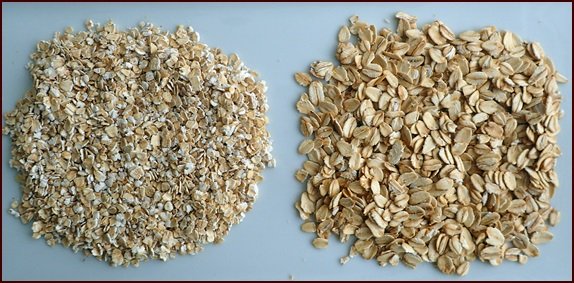
Photo: Use old-fashioned rolled oats, shown on right, for making granola.
According to Healthline, “The soluble fiber in oats helps reduce cholesterol and blood sugar levels, promotes healthy gut bacteria, and increases feelings of fullness. Oats contain minerals, vitamins, and antioxidant plant compounds including manganese, phosphorus, magnesium, copper, iron, zinc, folate, vitamin B1 (thiamin), and vitamin B5 (pantothenic acid).” Oats are gluten-free if not processed in a factory that also processes wheat.
Ground Flaxseeds
Flaxseeds are nutritious and full of both soluble and insoluble fiber. They are high in thiamine, a B vitamin important for energy metabolism, and they contain numerous minerals. Use ground seeds to unleash their full nutritional benefits, because whole seeds pass through the digestive tract largely undigested. Ground flaxseeds have a natural ability to bind other ingredients, which makes them perfect for forming granola clusters.
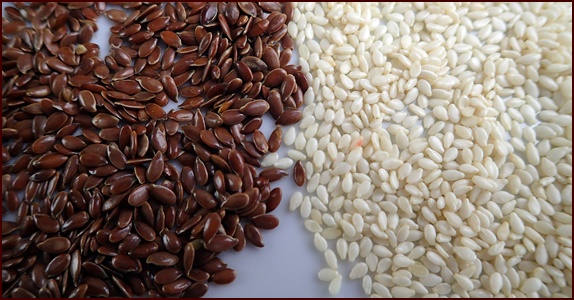
Photo: Flaxseeds (left) and sesame seeds (right) are nutritious additions to granola recipes. Grind them first for better absorption of nutrients.
Sesame Seeds
Sesame seeds are also packed with fiber, vitamins, minerals, and antioxidants to compliment the nutrients found in flaxseeds. According to Healthline, “Sesame seeds are low in carbohydrates and high in protein and healthy fats, which may support blood sugar control.” Grinding sesame seeds before adding them to granola increases the bioavailability of the nutrients in them, but if that's too much trouble, just add them whole.
Sunflower Seed Kernels
Sunflower seed kernels are rich in heart-healthy fats. They are high in vitamin E, a powerful antioxidant that protects cells from damage, and they provide significant amounts of magnesium for muscle and nerve function. Additionally, they contain protein and B vitamins that support energy metabolism.
They contribute a bit of nutty flavor and chewy texture to the granola.
Wheat germ
Wheat germ is the nutrient-rich embryo of the wheat kernel. It's a concentrated source of vitamins, minerals, fiber, and healthy fats, including omega-3 and omega-6 fatty acids. Wheat germ is also a good source of plant-based protein, vitamin E, folate, thiamin, magnesium, zinc, and phosphorus.
Wheat germ contains gluten, so omit this ingredient if you are avoiding gluten.
Pecans or Walnuts
Pecans contain more than 19 vitamins and minerals, including vitamin A, vitamin E, folic acid, calcium, magnesium, phosphorus, potassium, several B vitamins and zinc. They are an excellent source of fiber, healthy fats, and protein.
Walnuts are an excellent source of plant-based omega-3 fatty acids, which support heart and brain health. They also provide antioxidants, protein, and minerals like magnesium and copper. Walnuts may help reduce inflammation and improve cholesterol levels.
I like to chop either of these nutritious nuts into smaller pieces to release their full flavor into the granola, while ensuring they get a good coating of the sweeteners.
Real Maple Syrup
Unlike fake maple syrup, which is made with refined sugar and high-fructose corn syrup, real maple syrup actually contains vitamins and minerals. I use just enough so that the granola is sweet but not sticky after baking it.
Honey
Honey also has advantages over refined sugar. According to the Mayo Clinic, “Honey contains mostly sugar, as well as a mix of amino acids, vitamins, minerals, iron, zinc and antioxidants.”
The liquid nature of maple syrup and honey help bind the oats into clusters—sometimes 5 or 6 oats stuck together, sometimes 2 or 3, always delicious. Of the two sweeteners, honey is slightly better at forming the largest granola clusters.
Sunflower Oil
Sunflower oil is rich in vitamin E, unsaturated fats, and other beneficial compounds. A little fat in the form of oil is a source of energy for hikers on the go.
I use just enough sunflower oil to toast the granola to a light-brown color in the oven, and far less than is used to make oatmeal cookies.
Although I prefer sunflower oil, any neutral-flavored cooking oil may be used, including coconut oil. If using coconut oil, warm it above room temperature to a liquid state.
Hold the Raisins, Dried Fruits & Coconut Flakes.
There is no need to roast these healthy ingredients in the oven with the granola. Add them to the granola after it has cooled.
Raisins actually get less sweet and harder if you bake them with the granola.
Chef Glenn’s Best Granola Recipe
Cookware:
- Half-sheet baking pan, approximately 18” x 13” x 1”.
- Parchment paper, aka baking paper.
- Mixing bowl.
Ingredients:
Makes 6 cups (635 g).
- 4 cups old-fashioned rolled oats (400 g)
- ⅓ cup chopped pecans or walnuts (35 g)
- 2 Tbsp. ground flaxseeds
- 2 Tbsp. sesame seeds, whole or ground
- 2 Tbsp. sunflower seed kernels, whole
- 2 Tbsp. wheat germ
- ½ tsp. cinnamon
- ½ tsp. salt
- ¼ cup sunflower oil (60 ml)
- ½ cup real maple syrup or honey (175 ml)
Maple Syrup or Honey?
I love making this healthy granola recipe with both sweeteners; each offers its own unique flavor. I usually keep a jar of each on hand for variety. The honey option binds more of the oats together than maple syrup, and it finishes with a more golden color.
I have also made this granola recipe with a 50/50 mix of honey and maple syrup… a delicious mingling of sweetness from the bees and trees.
Mix the Granola Ingredients
- If you start with whole flaxseeds, it’s best to grind them first for better digestibility. Sesame seeds can be used either ground or whole.
- Chop nuts into smaller pieces.
- Combine all dry ingredients in a big bowl.
- In a small bowl, stir maple syrup or honey into sunflower oil until well-combined.
- Pour combined liquid ingredients over the dry ingredients and stir until evenly coated.
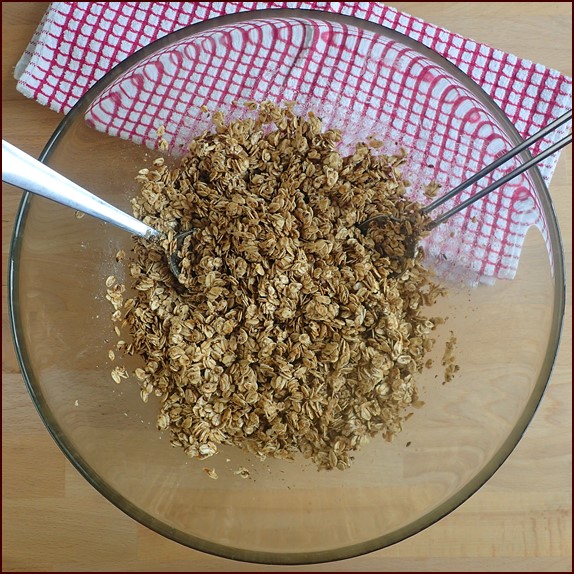
Photo: Mixing dry granola ingredients with wet ingredients. Toss like a salad with two spoons.
Bake the Granola
What is the best temperature to bake granola?
I tested baking granola at 350°F (176°C) and 325°F (160°C). Either temperature works, but at the higher temperature, the granola turns out darker and crispier, with a hint of bitter flavor due to caramelization of the sugars in the maple syrup or honey.
At the lower temperature, the granola will have a golden-brown color, perfect crunch, excellent flavor and sweetness, and optimal clustering of the oats.
Preheat oven to 325°F (160°C).
The total time to bake granola is 25 minutes.
Stir the granola around two times during the baking process, so it bakes evenly with uniform color and minimal caramelization of the sweeteners.

I use a stopwatch to keep track of the time the granola is in the oven—stopping the clock during the time that the granola is taken out of the oven for stirring at 12 minutes and 20 minutes.
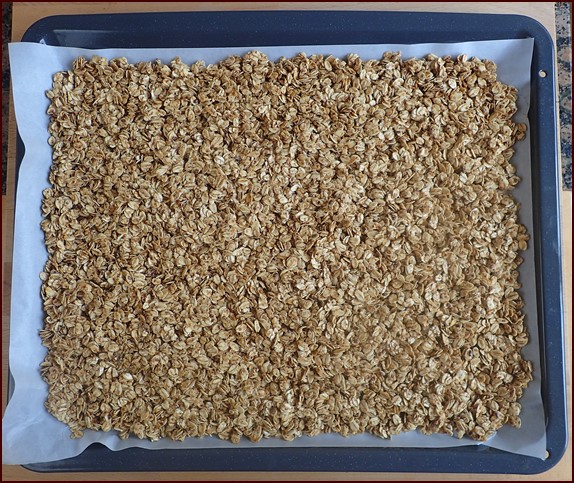
- Spread granola mixture on a half-sheet baking pan using parchment paper. Place in preheated oven and bake for 12 minutes.
- Remove pan from oven and stir. My method of stirring the granola is to hold the parchment paper in place with a spoon while scraping the granola to the center with a spatula. Then spread it around evenly again.
- Return pan to oven and continue baking for another eight minutes. Remove pan from oven and stir the granola.
- Return pan to oven and continue baking for the last five minutes.
- Remove pan from oven and let granola sit undisturbed for 15 or more minutes.
- Once cool enough to handle, crumble the granola into small clusters.
- Allow granola to completely cool before placing it in an airtight container for storage.
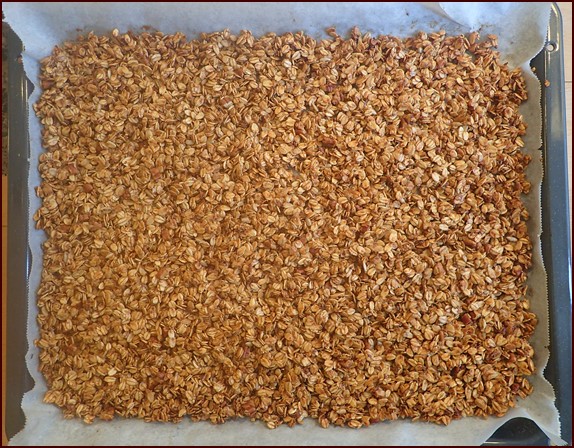
Photo above: Homemade granola sweetened with maple syrup.
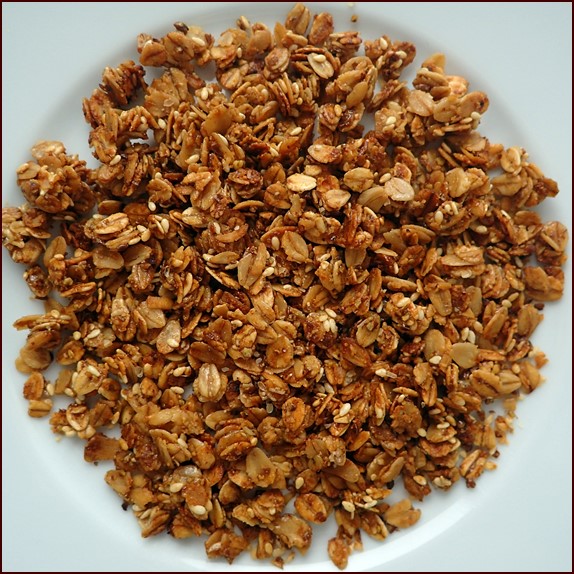
Photo: Homemade granola sweetened with honey.
Peanut Butter Granola Recipes
Peanut butter adds an extra level of rich flavor to the basic granola recipe. There are two easy ways to get your peanut butter fix.
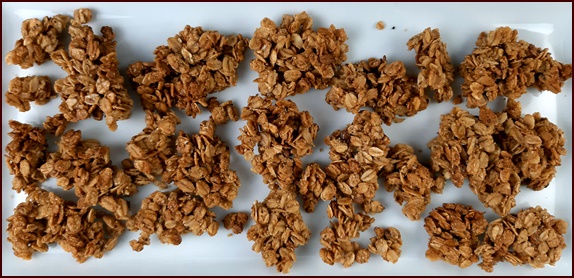
Photo: Homemade peanut butter granola.
Method One:
Extra Ingredient: ⅓ cup (25 g) peanut butter powder.
Follow the basic granola recipe above using maple syrup or honey as the sweetener. Add the peanut butter powder to the rolled oats and other dry ingredients before mixing in the oil and sweetener.
Shop peanut butter powder on Amazon (affiliate link).
Method Two:
Extra Ingredient: 2 Tbsp. all-natural peanut butter.
Add the peanut butter to the small bowl with the oil and sweetener. Stir until completely combined, then mix liquid into the dry ingredients.
How to Make Granola Clusters
Of the two granola sweeteners, honey forms larger granola clusters than maple syrup. But if you combine either type of granola with blended fruit, and dry it in a dehydrator, you’ll be amazed at the delicious, fruity granola clusters you will create.
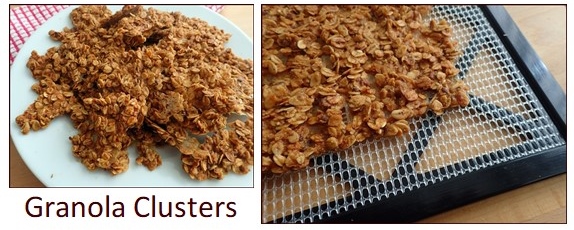
Photo: Granola clusters dried in a dehydrator.
Making granola clusters is easy:
- Blend or mash fruit into a sauce.
- Combine with homemade granola.
- Dehydrate at 135°F (57°C) for approx. 11 hours.
Granola Clusters Recipes
Apple-Granola Clusters Recipe
Ingredients:
- 2 cups granola (maple syrup sweetened) (200 g)
- 2 apples
- 3 Tbsp. apple juice or cranberry juice
- 1 Tbsp. fresh-squeezed lemon juice
- 1 tsp. maple syrup
- ¼ tsp. cinnamon
How to Make Granola Clusters with Apples
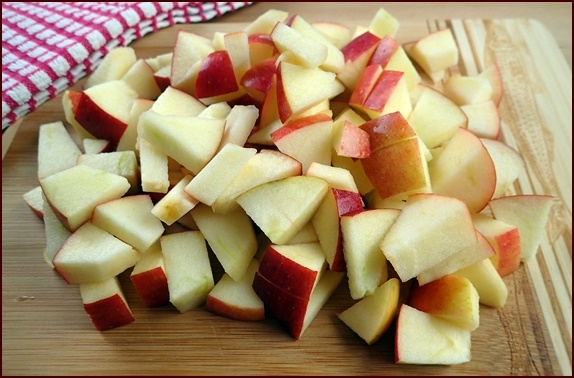
Make the Applesauce:
Target yield is 1 cup of applesauce.
Dice apples and place in blender with apple/cranberry juice, and lemon juice. Blend into sauce.
Stir in maple syrup and cinnamon.
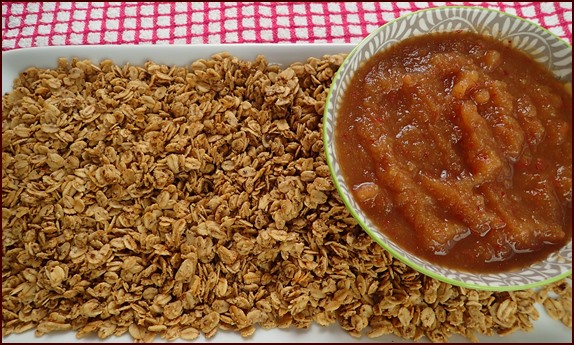
Photo: Homemade granola and applesauce before combining.
Combine 1 cup of applesauce with 2 cups of homemade granola.
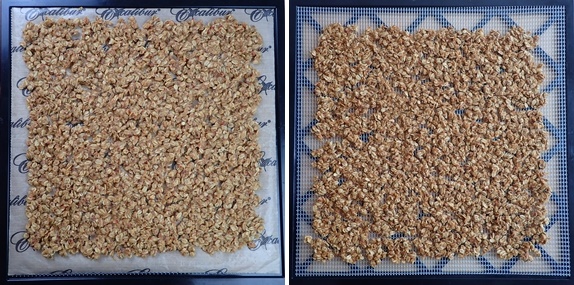
Photos: (L) Applesauce/granola mixture spread on dehydrator tray over nonstick sheet. (R) Granola clusters drying on tray after nonstick sheet removed.
Dehydrating Apple-Granola Clusters
Spread apple-granola mixture on dehydrator tray over a nonstick sheet.
Dehydrate at 135°F (57°C) for approximately 11 hours.
After about 6 hours, flip tray over onto another tray and remove the nonstick sheet.
Continue drying until clusters are firm and snappy.
Allow to cool, and break into granola clusters of desired sizes.
Store in an airtight container. Best when used within 1 month.
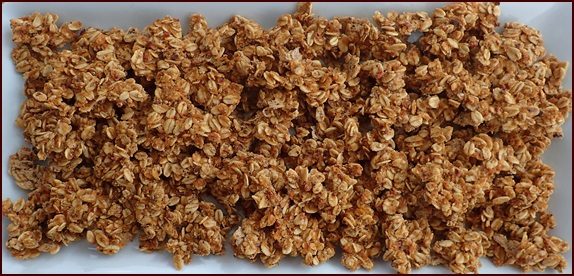
Photo: Apple-Granola Clusters. Delicious!
Pineapple-Granola Clusters Recipe
Ingredients:
- 2 cups granola (honey sweetened) (200 g)
- 1½ cups pineapple chunks*
- 3 Tbsp. pineapple juice
* Easiest to use canned pineapple packed in its own juice, no extra sugar.
How to Make Granola
Clusters with Pineapple
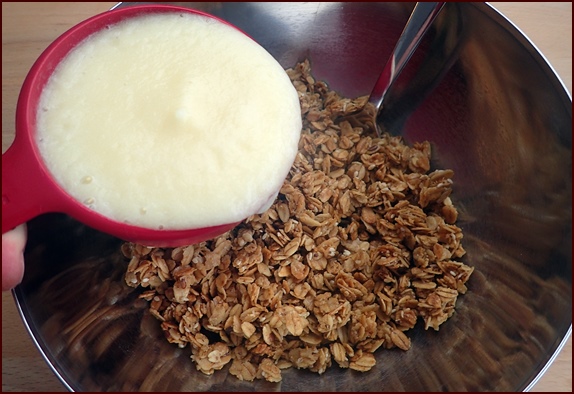
Photo: Combining blended pineapple with granola.
Run pineapple chunks and juice through a blender until smooth.
Combine blended pineapple with granola.
Dehydrate the same way as the other granola clusters.
Banana-Granola Clusters Recipe
Ingredients:
- 2 cups granola (honey sweetened) (200 g)
- 2 bananas
- 1 lemon
- 1 tsp. honey
How to Make Granola Clusters with Bananas
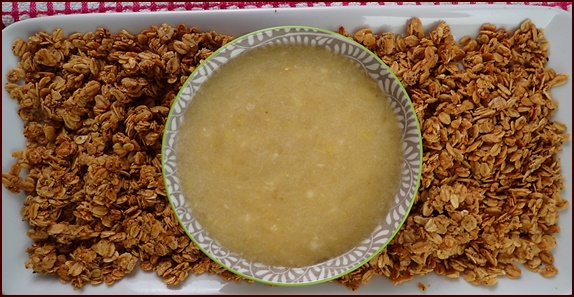
Photo: Homemade granola and banana purée before combining.
Make the Banana Purée:
Target yield is 1 cup of banana purée.
Dice bananas and place in a flat-bottom pot. Grate the peel of 1 lemon and add to bananas with 2 Tbsp. of lemon juice and 1 tsp. of honey.
Mash into a purée with a potato masher.
Combine 1 cup of banana purée with 2 cups of homemade granola.
Dehydrating Banana-Granola Clusters
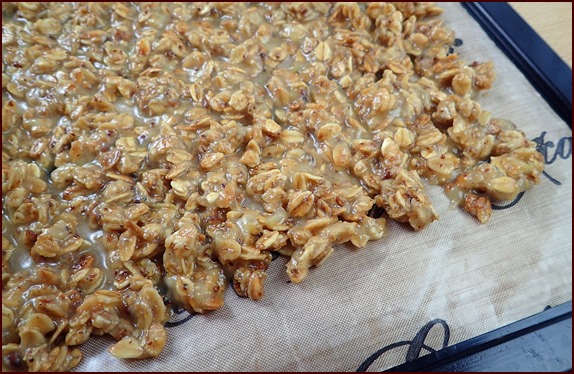
Photo: Banana-granola mixture on dehydrator tray over nonstick sheet.
Spread banana-granola mixture on dehydrator tray over a nonstick sheet.
Dehydrate at 135°F (57°C) for approximately 11 hours.
After about 6 hours, flip tray over onto another tray and remove the nonstick sheet.
Continue drying until clusters are firm and snappy.
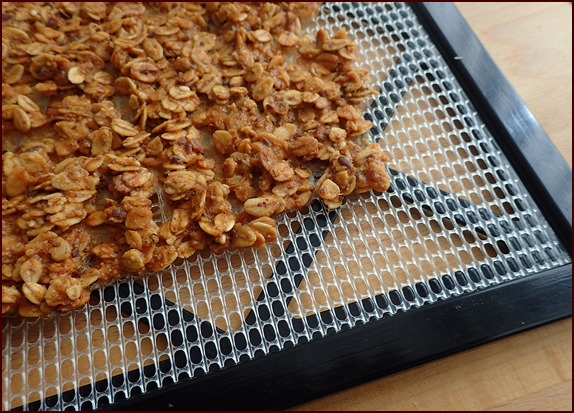
Photo: Banana-granola mixture near end of drying directly on mesh sheet.
Allow to cool, and break into granola clusters of desired sizes.
Store in an airtight container. Best when used within 1 month.
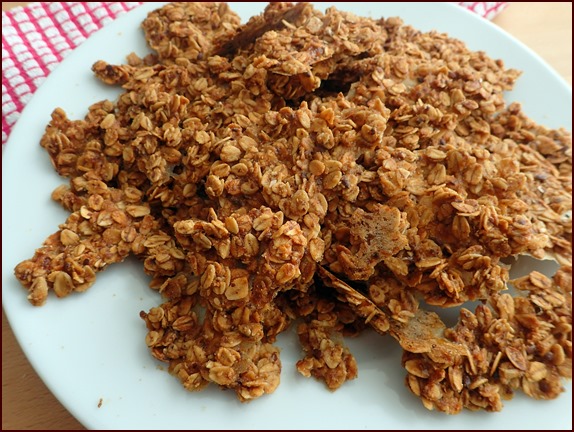
Photo: Banana-granola clusters. Delicious!
Orange-Granola Clusters Recipe
Ingredients:
- 2 cups granola (honey-sesame recipe) (200 g)
- 2 oranges (300 g), plus the peels
- 1 Tbsp. sugar
- 2 tsp. orange juice
How to Make Orange-Granola Clusters
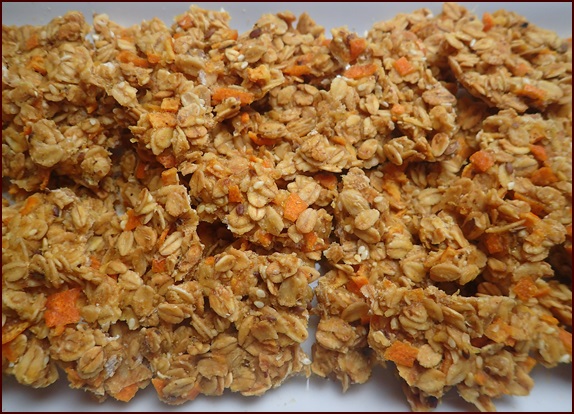
Peel 2 oranges and remove as much pith as possible. Retain the peels.
Scrape pith off underside of peels with a spoon.
Chop peels into bits with a knife and place in a bowl.
Combine peels with 1 tablespoon of sugar and 1 teaspoon of orange juice. Let sit for a few minutes. The peels don’t go in the blender.
Run orange chunks through a blender until smooth.
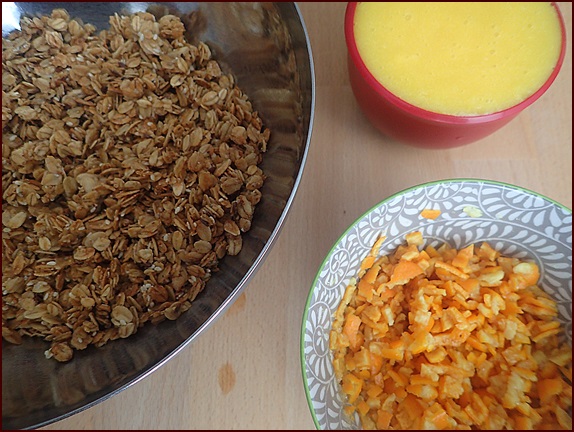
Combine blended oranges with granola and sweetened orange peel bits.
Dehydrating Orange-Granola Clusters
Spread mixture on dehydrator tray using a nonstick sheet or silicone tray.
Dehydrate at 135°F (57°C) for approximately 11 hours total.
When the granola is mostly dry, flip the tray over onto another tray and remove the nonstick sheet. Continue drying until frim and snappy.
Break the dried sheet into granola clusters.
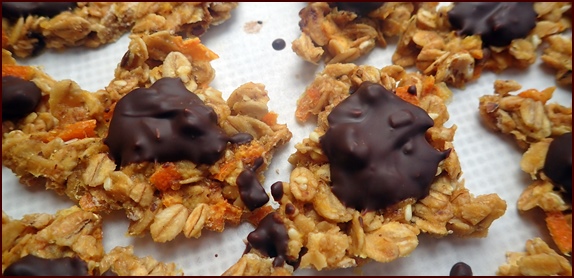
Orange-Granola clusters are amazing topped with chocolate. Try Lindt Intense Orange Chocolate.
Chocolate Covered Granola Clusters
Take your homemade granola clusters to the next level with a chocolate topping.
The best chocolate for melting is dark chocolate. Use plain chocolate with a high cocoa percentage or dark chocolate infused with intense flavors. The Lindt brand is delicious and is available with intense flavor options such as caramel, orange, pear, and berries.
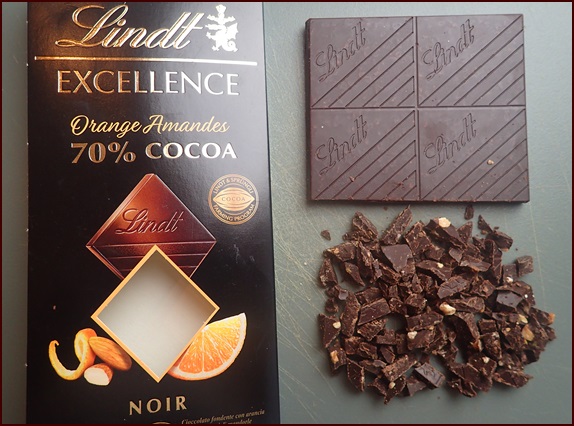
Photo: Lindt chocolate chopped into smaller pieces.
Melt chocolate in a microwave using a microwave-safe container (30% power in 30 second intervals), or melt chocolate using the double-boiler method as follows:
Add an inch of water to a saucepan. Place a heat-safe bowl inside the saucepan. Use a bowl that is slightly smaller than the pan with its top resting on the top rim of the pan. To reduce direct heat transfer, put a couple of spoons in the pan to elevate the bowl off the bottom of the pan. You want to melt the chocolate, not cook it.
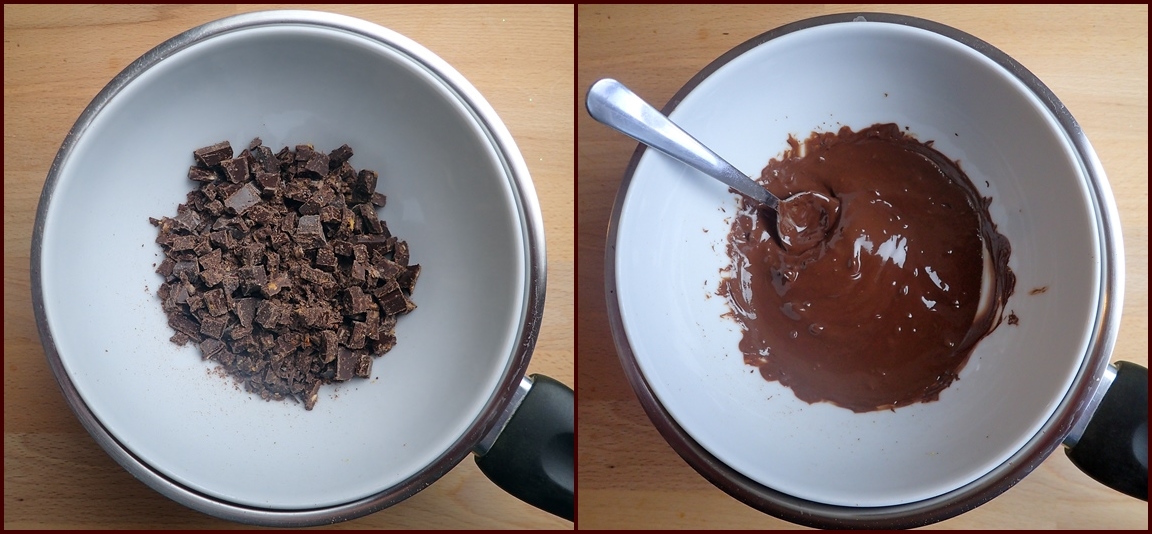
Cut the chocolate into smaller pieces and place it inside the bowl. Turn the heat up to about medium. It’s not necessary to heat the water all the way to a boil.
Stir the chocolate while it melts until it has a smooth viscosity.
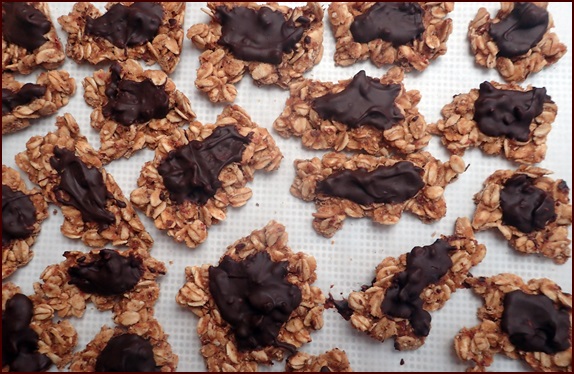
Photo: Apple-granola clusters topped with chocolate. Lindt chocolate with infused caramel goes great on top of the apple granola, but any dark chocolate will do.
Place granola clusters on a tray covered with parchment paper or a nonstick sheet.
Apply chocolate over clusters with a teaspoon.
Place tray in refrigerator for 10–15 minutes until chocolate hardens, then you can pack them more closely together in a container with a lid.
DIY Granola Ideas
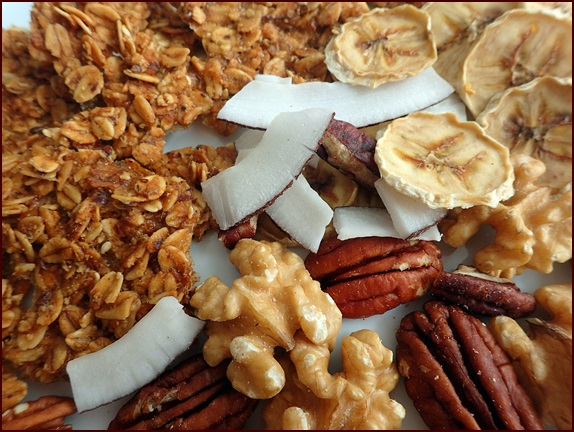
Photo: Enjoy homemade granola or granola clusters “as is” or add them to trail mixes with nuts and dried fruits.
DIY Granola Trail Mix
Variety is key for long backpacking trips so you don’t get tired of eating the same granola every day.
Make individual servings of granola trail mix with different dried fruits, nuts, and seeds. Chocolate and dried coconut are also nice additions.
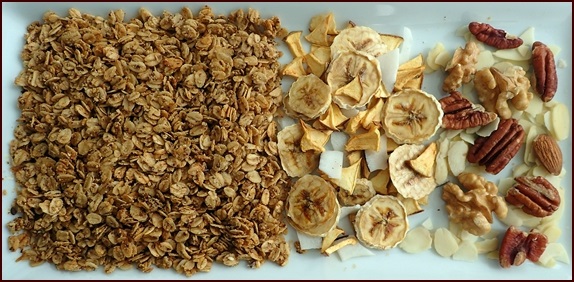
Granola & Milk for Breakfast
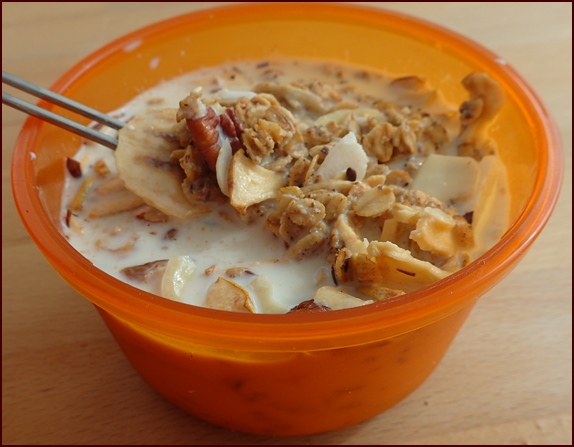
Ingredients:
- 1 cup homemade granola
- ¼ cup dried fruit
- ¼ cup nuts and dried coconut
- 1 cup milk
On the trail, make milk with powdered milk. (1 cup water and 4 Tbsp. milk powder for most brands)
Granola Topping
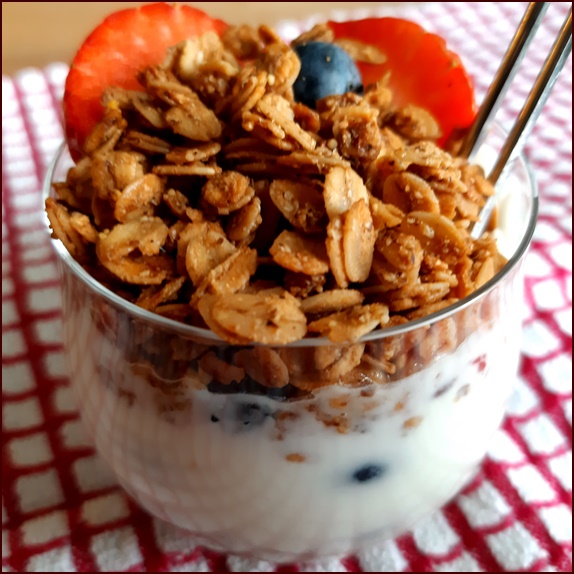
Photo: Enjoy homemade granola at home with yogurt and fruit.
On the trail, add granola or granola clusters to fruit puddings made from fruit leather.
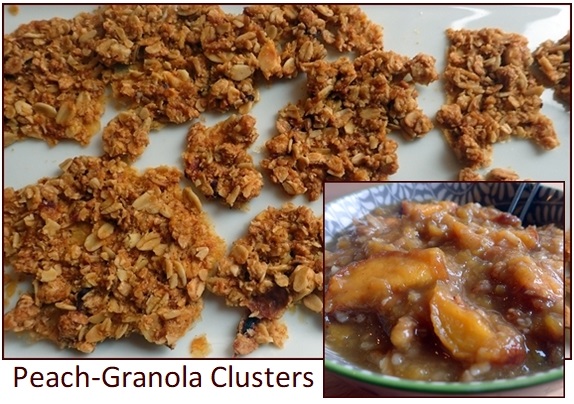
Photos: Peach-granola clusters for trail snacking, or added to hot peach crumble backpacking dessert.
Explore More…
How to Make Granola Clusters with Peaches
How to Make Granola Clusters with Strawberries
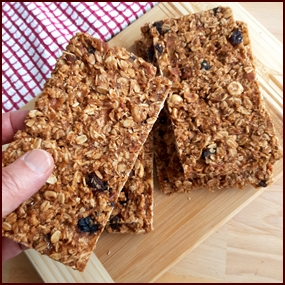
Shop Amazon
Dehydrators & Accessories for making Apple-Granola Clusters.

Excalibur 9-Tray Dehydrator (trays shown above)
Nonstick sheets for Excalibur Dehydrator
Cosori Stainless Steel 6-Tray Dehydrator
Silicone Dehydrator Trays with Raised Edges, 11.8" x 10.8", 6-Pack
Silicone Mesh Dehydrator Sheets, 14” x 14”, 12-Pack
Disclosure: As an Amazon Associate, Backpacking Chef earns from qualifying purchases. Thank you!
Share this page with friends on social media.
Free E-book & Newsletter
Free with Trail Bytes subscription.
Dehydrating Food from A–Z

